NCERT Solutions for Class 10 Maths Chapter 3 Exercise 3.1 - Pair of Linear Equations in two variables
The exercise explains how to solve a pair of linear equations through graphical methods. The lesson establishes how two linear equations display as straight lines on a Cartesian coordinate system, where their point of intersection reveals the solution. The visualisation enables learners to determine the solution possibilities based on the line behaviour of lines intersecting or being parallel, or coinciding. The process reveals how algebra functions together with geometric principles to solve problems that exist in the real world.
This Story also Contains
- NCERT Solutions Class 10 Maths Chapter 3: Exercise 3.1
- Access Solution of Pair of Linear Equations in Two Variables Class 10 Chapter 3 Exercise: 3.1
- Topics covered in Chapter 3 Pair of Linear Equations in Two Variables: Exercise 3.1
- NCERT Solutions of Class 10 Subject Wise
- NCERT Exemplar Solutions of Class 10 Subject Wise
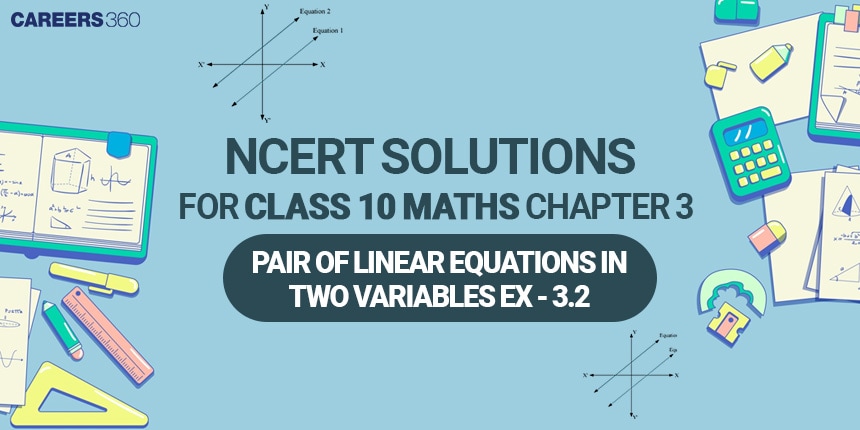
Understandings of two-variable linear equation behaviour in graphical representations are taught in this essential section of the NCERT Solutions for Class 10 Maths. Students who perform exercise gain deeper comprehension about linear equation graphical solutions and system consistency, and how it determines unique versus infinite solutions. The clear presentation of the solutions given in the NCERT Books enables students' understanding of the connection between graphical interpretations and algebraic processes before moving on to complex multisystem topics in higher education.
Access Solution of Pair of Linear Equations in Two Variables Class 10 Chapter 3 Exercise: 3.1
Answer:
Let the number of boys be x and the number of girls be y.
Now, according to the question,
Total number of students in the class = 10, i.e.
$\Rightarrow x+y=10.....(1)$
And, given that the number of girls is 4 more than the number of boys it means; $x=y+4$
$\Rightarrow x-y=4..........(2)$
Different points (x, y) satisfying equation (1)
X | 5 | 6 | 4 |
Y | 5 | 4 | 6 |
Different points (x,y) satisfying equation (2)
X | 5 | 6 | 7 |
y | 1 | 2 | 3 |
Graph,
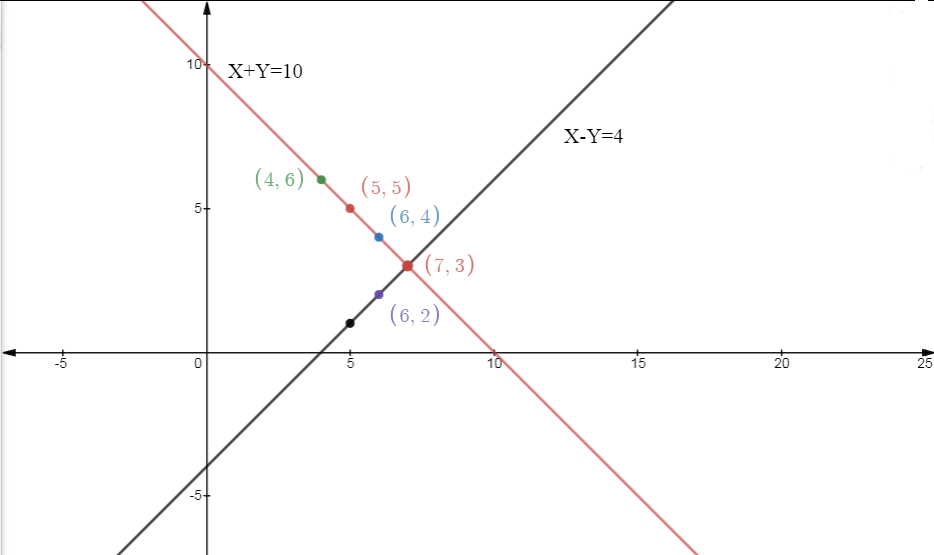
From the graph, both lines intersect at the point (7,3). That is x = 7 and y = 3, which means the number of boys in the class is 7 and the number of girls in the class is 3.
Answer:
Let the price of 1 pencil be x, and y be the price of 1 pen.
Now, according to the question
$5x+7y=50......(1)$
And
$7x+5y=46......(2)$
Now, the points (x,y) that satisfy the equation (1) are
X | 3 | -4 | 10 |
Y | 5 | 10 | 0 |
And, the points (x,y) that satisfy the equation (2) are
X | 3 | 8 | -2 |
Y | 5 | -2 | 12 |
The Graph,
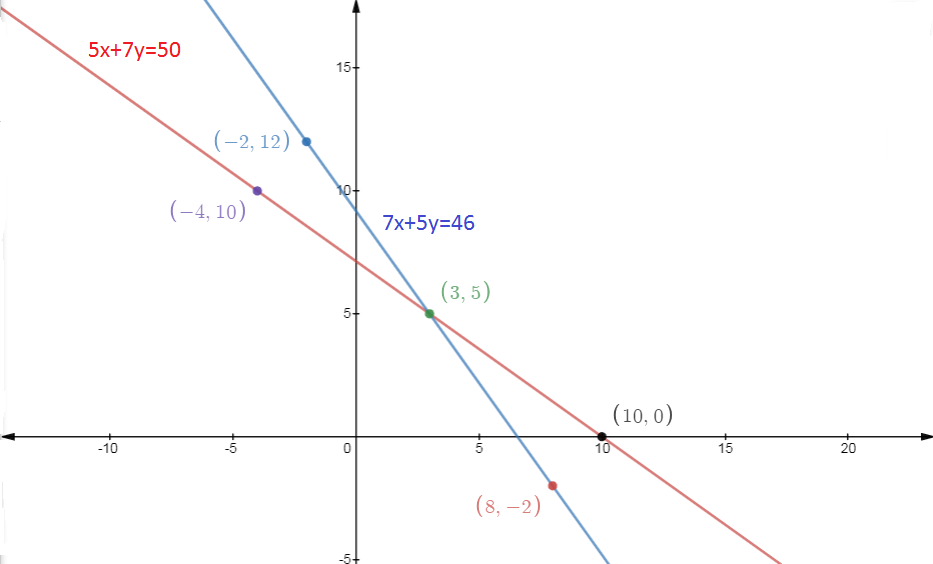
From the graph, both lines intersect at point (3,5), that is, x = 3 and y = 5, which means the cost of 1 pencil is 3 and the cost of 1 pen is 5.
Answer:
Given Equations,
$\\5x - 4y + 8 = 0 $and$ 7x + 6y - 9 = 0$
Comparing these equations with $a_1x+b_1y+c_1=0\:and\:a_2x+b_2y+c_2=0$ , we get
$\frac{a_1}{a_2}=\frac{5}{7},\:\frac{b_1}{b_2}=\frac{-4}{6}\:and\:\frac{c_1}{c_2}=\frac{8}{-9}$
It is observed that;
$\frac{a_1}{a_2}\neq\frac{b_1}{b_2}$
It means that both lines intersect at exactly one point and have a unique solution.
Answer:
Given Equations,
$\\9x + 3y + 12 = 0$ and $18x + 6y + 24 = 0$
Comparing these equations with $a_1x+b_1y+c_1=0\:and\:a_2x+b_2y+c_2=0$ , we get
$\\\frac{a_1}{a_2}=\frac{9}{18}=\frac{1}{2},\\\:\frac{b_1}{b_2}=\frac{3}{6}=\frac{1}{2}\: and \\\:\frac{c_1}{c_2}=\frac{12}{24}=\frac{1}{2}$
It is observed that;
$\frac{a_1}{a_2}=\frac{b_1}{b_2}=\frac{c_1}{c_2}$
It means that both lines are coincident and have infinitely many solutions.
Q2 (iii) On comparing the ratios $\frac{a_1}{a_2}$, $\frac{b_1}{b_2}$and $\frac{c_1}{c_2}$ , find out whether the lines representing the following pairs of linear equations intersect at a point, are parallel or coincident: (iii) $\\6x - 3y + 10 = 0; \\ 2x - y+ 9 = 0$
Answer:
Given Equations,
$\\6x - 3y + 10 = 0$ and$ 2x - y+ 9 = 0$
Comparing these equations with $a_1x+b_1y+c_1=0\:and\:a_2x+b_2y+c_2=0$ , we get
$\frac{a_1}{a_2}=\frac{6}{2}=3,\:\frac{b_1}{b_2}=\frac{-3}{-1}=3\:and\:\frac{c_1}{c_2}=\frac{10}{9}$
It is observed that;
$\frac{a_1}{a_2}=\frac{b_1}{b_2}\neq\frac{c_1}{c_2}$
It means that both lines are parallel and thus have no solution.
Answer:
Given Equations,
$\\3x + 2y = 5$ and $2x - 3y = 7$
Or, $3x + 2y - 5 = 0$ and $ 2x - 3y - 7 = 0$
Comparing these equations with $a_1x+b_1y+c_1=0\:and\:a_2x+b_2y+c_2=0$ , we get
$\frac{a_1}{a_2}=\frac{3}{2},\:\frac{b_1}{b_2}=\frac{2}{-3}\:and\:\frac{c_1}{c_2}=\frac{5}{7}$
It is observed that;
$\frac{a_1}{a_2}\neq\frac{b_1}{b_2}$
It means that the given equations have a unique solution and thus the pair of linear equations is consistent.
Answer:
Given Equations,
$\\2x - 3y = 8$ and $4x - 6y = 9$
Or, $\\2x - 3y - 8 = 0$ and $4x - 6y - 9 = 0$
Comparing these equations with $a_1x+b_1y+c_1=0\:and\:a_2x+b_2y+c_2=0$ , we get
$\\\frac{a_1}{a_2}=\frac{2}{4}=\frac{1}{2},\\\:\frac{b_1}{b_2}=\frac{-3}{-6}=\frac{1}{2}\:and\\\:\frac{c_1}{c_2}=\frac{8}{9}$
It is observed that;
$\frac{a_1}{a_2}=\frac{b_1}{b_2}\neq\frac{c_1}{c_2}$
It means the given equations have no solution, and thus the pair of linear equations is inconsistent.
Answer:
Given Equations,
$\\\frac{3}{2}x + \frac{5}{3}y = 7$ and $9x -10y = 14$
Or, $\\\frac{3}{2}x + \frac{5}{3}y - 7 = 0$ and $9x -10y - 14 = 0$
Comparing these equations with $a_1x+b_1y+c_1=0\:and\:a_2x+b_2y+c_2=0$ , we get
$\\\frac{a_1}{a_2}=\frac{3/2}{9}=\frac{3}{18}=\frac{1}{6},\\\:\frac{b_1}{b_2}=\frac{5/3}{-10}=\frac{5}{-30}=-\frac{1}{6}\:and\\\:\frac{c_1}{c_2}=\frac{7}{14}=\frac{1}{2}$
It is observed that;
$\frac{a_1}{a_2}\neq\frac{b_1}{b_2}$
It means the given equations have exactly one solution, and thus the pair of linear equations is consistent.
Answer:
Given Equations,
$5x - 3y = 11$ and $-10x + 6y =-22$
Or, $5x - 3y - 11 = 0$ and $-10x + 6y + 22 = 0$
Comparing these equations with $a_1x+b_1y+c_1=0\:and\:a_2x+b_2y+c_2=0$ , we get
$\\\frac{a_1}{a_2}=\frac{5}{-10}=-\frac{1}{2},\\\:\frac{b_1}{b_2}=\frac{-3}{6}=-\frac{1}{2}\:and\\\:\frac{c_1}{c_2}=\frac{11}{-22}=-\frac{1}{2}$
It is observed that;
$\frac{a_1}{a_2}=\frac{b_1}{b_2}=\frac{c_1}{c_2}$
It means the given equations have an infinite number of solutions, and thus a pair of linear equations is consistent.
Answer:
Given Equations,
$\\\frac{4}{3}x + 2y = 8$ and $2x + 3y = 12$
Or, $\\\frac{4}{3}x + 2y - 8 = 0$ and $2x + 3y - 12 = 0$
Comparing these equations with $a_1x+b_1y+c_1=0\:and\:a_2x+b_2y+c_2=0$ , we get
$\\\frac{a_1}{a_2}=\frac{4/3}{2}=\frac{4}{6}=\frac{2}{3},\\\:\frac{b_1}{b_2}=\frac{2}{3}\:\:and\\\:\frac{c_1}{c_2}=\frac{8}{12}=\frac{2}{3}$
It is observed that;
$\frac{a_1}{a_2}=\frac{b_1}{b_2}=\frac{c_1}{c_2}$
It means the given equations have an infinite number of solutions, and thus a pair of linear equations is consistent.
Answer:
Given Equations,
$\\x + y = 5$ and $2x + 2 y = 10$
Comparing these equations with $a_1x+b_1y+c_1=0\:and\:a_2x+b_2y+c_2=0$ , we get
$\\\frac{a_1}{a_2}=\frac{1}{2},\\\:\frac{b_1}{b_2}=\frac{1}{2}\:and\\\:\frac{c_1}{c_2}=\frac{5}{10}=\frac{1}{2}$
It is observed that;
$\frac{a_1}{a_2}=\frac{b_1}{b_2}=\frac{c_1}{c_2}$
It means the given equations have an infinite number of solutions, and thus a pair of linear equations is consistent.
The points (x,y) which satisfy both equations are
X | 1 | 3 | 5 |
Y | 4 | 2 | 0 |
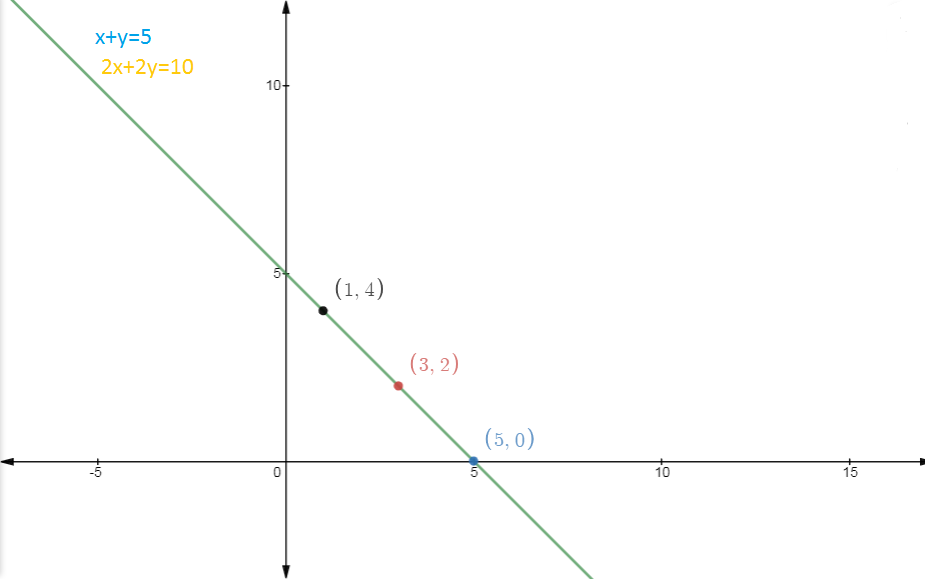
Answer:
Given Equations,
$\\x - y = 8$ and $3x - 3y = 16$
Comparing these equations with $a_1x+b_1y+c_1=0\:and\:a_2x+b_2y+c_2=0$ , we get
$\\\frac{a_1}{a_2}=\frac{1}{3},\\\:\frac{b_1}{b_2}=\frac{-1}{-3}=\frac{1}{3}\:and\\\:\frac{c_1}{c_2}=\frac{8}{16}=\frac{1}{2}$
It is observed that:
$\frac{a_1}{a_2}=\frac{b_1}{b_2}\neq\frac{c_1}{c_2}$
It means the given equations have no solution, and thus the pair of linear equations is inconsistent.
Answer:
Given Equations,
$\\2x + y - 6 =0$ and $4x - 2 y - 4 = 0$
Comparing these equations with $a_1x+b_1y+c_1=0\:and\:a_2x+b_2y+c_2=0$ , we get
$\\\frac{a_1}{a_2}=\frac{2}{4}=\frac{1}{2},\\\:\frac{b_1}{b_2}=\frac{1}{-2}=-\frac{1}{2}\:and\\\:\frac{c_1}{c_2}=\frac{-6}{-4}=\frac{3}{2}$
It is observed that;
$\frac{a_1}{a_2}\neq\frac{b_1}{b_2}$
It means the given equations have exactly one solution, and thus the pair of linear equations is consistent.
The points(x, y) satisfying the equation $\\2x + y - 6 =0$ are,
X | 0 | 2 | 3 |
Y | 6 | 2 | 0 |
And The points(x,y) satisfying the equation $\\4x - 2y - 4 = 0$ are,
X | 0 | 1 | 2 |
Y | -2 | 0 | 2 |
GRAPH:
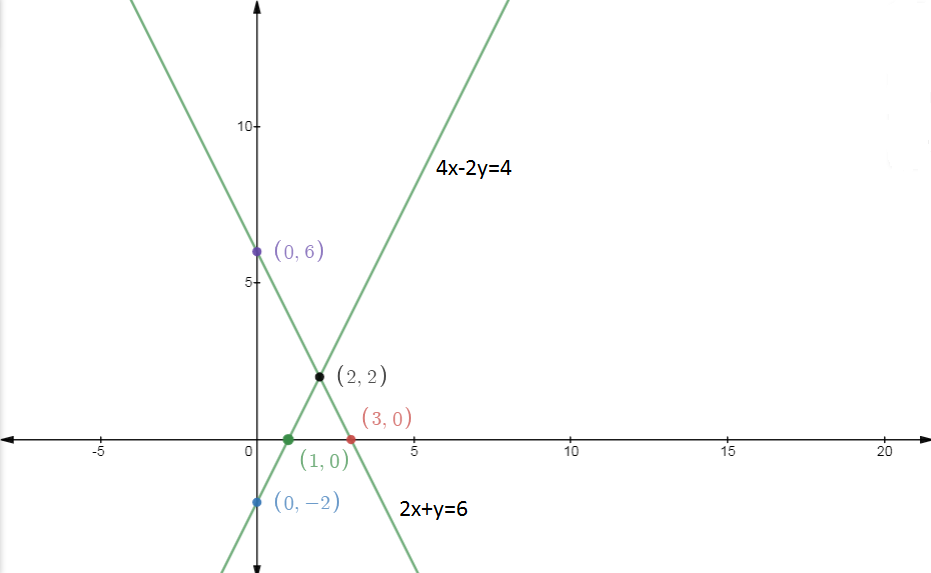
As we can see, both lines intersect at point (2,2) and hence the solution of both equations is x = 2 and y = 2.
Answer:
Given Equations,
$\\2x - 2y - 2 =0, \qquad\\ 4x - 4y -5 = 0$
Comparing these equations with $a_1x+b_1y+c_1=0\:and\:a_2x+b_2y+c_2=0$ , we get
$\\\frac{a_1}{a_2}=\frac{2}{4}=\frac{1}{2},\\\:\frac{b_1}{b_2}=\frac{-2}{-4}=\frac{1}{2}\:and\\\:\frac{c_1}{c_2}=\frac{-2}{-5}=\frac{2}{5}$
It is observed that;
$\frac{a_1}{a_2}=\frac{b_1}{b_2}\neq\frac{c_1}{c_2}$
It means the given equations have no solution, and thus the pair of linear equations is inconsistent.
Answer:
Let $ l$ be the length of the rectangular garden and $b$ be the width.
Now, according to the question, the length is 4 m more than its width, so we can write it as $l=b+4$
Or, $l-b=4....(1)$
Also given Half Parameter of the rectangle = 36 it means $l+b=36....(2)$
Now, as we have two equations, add both equations, and we get,
$l+b+l-b=4+36$
$\Rightarrow 2l=40$
$\Rightarrow l=20$
We get the value of $l$, which is 20m
Now, putting this in equation (1), we get;
$\Rightarrow 20-b=4$
$\Rightarrow b=20-4$
$\Rightarrow b=16$
Hence, the Length and width of the rectangle are 20m and 16m, respectively.
Answer:
Given the equation,
$2x + 3y -8 =0$
We know that the condition for the intersection of lines for the equations in the form $ a_1x+b_1y+c_1=0$ and $ a_2x+b_2y+c_2=0$ is,
$\frac{a_1}{a_2}\neq\frac{b_1}{b_2}$
So any line with this condition can be $4x+3y-16=0$
Proof,
$\frac{a_1}{a_2}=\frac{2}{4}=\frac{1}{2}$
$\frac{b_1}{b_2}=\frac{3}{3}=1$
Hence, $\frac{1}{2}\neq1$ it means $\frac{a_1}{a_2}\neq\frac{b_1}{b_2}$
Therefore, the pair of lines has a unique solution, thus forming intersecting lines.
Answer:
Given the equation,
$2x + 3y -8 =0$
As we know that the condition for the parallel lines for the equations in the form $ a_1x+b_1y+c_1=0$ and $ a_2x+b_2y+c_2=0$ is,
$\frac{a_1}{a_2}=\frac{b_1}{b_2}\neq\frac{c_1}{c_2}$
So any line with this condition can be $4x+6y-8=0$
Proof,
$\frac{a_1}{a_2}=\frac{2}{4}=\frac{1}{2}$
$\frac{b_1}{b_2}=\frac{3}{6}=\frac{1}{2}$
$\frac{c_1}{c_2}=\frac{-8}{-8}=1$
Hence, $\frac{1}{2}=\frac{1}{2}\neq1$ it means $\frac{a_1}{a_2}=\frac{b_1}{b_2}\neq\frac{c_1}{c_2}$
Therefore, the pair of lines has no solutions; thus lines are parallel.
Answer:
Given the equation,
$2x + 3y -8 =0$
As we know that the condition for the coincidence of the lines for the equations in the form $ a_1x+b_1y+c_1=0$ and $ a_2x+b_2y+c_2=0$ is,
$\frac{a_1}{a_2}=\frac{b_1}{b_2}=\frac{c_1}{c_2}$
So any line with this condition can be $4x+6y-16=0$
Proof,
$\frac{a_1}{a_2}=\frac{2}{4}=\frac{1}{2}$
$\frac{b_1}{b_2}=\frac{3}{6}=\frac{1}{2}$
$\frac{c_1}{c_2}=\frac{-8}{-16}=\frac{1}{2}$
Hence, $\frac{1}{2}=\frac{1}{2}=\frac{1}{2}$ it means $\frac{a_1}{a_2}=\frac{b_1}{b_2}=\frac{c_1}{c_2}$
Therefore, the pair of lines has infinitely many solutions; thus lines are coincident.
Answer:
Given two equations,
$x - y + 1=0.........(1)$
And
$3x +2 y - 12=0.........(2)$
The points (x,y) satisfying (1) are
X | 0 | 3 | 6 |
Y | 1 | 4 | 7 |
And The points(x,y) satisfying (2) are,
X | 0 | 2 | 4 |
Y | 6 | 3 | 0 |
GRAPH:
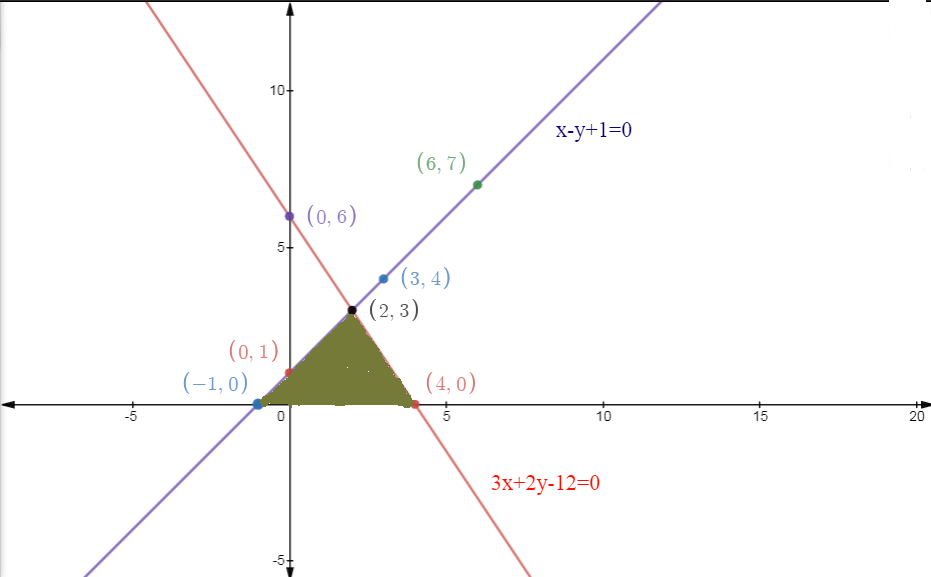
From the graph, we can see that both lines intersect at the point (2,3), and therefore the vertices of the Triangle are ( -1,0), (2,3) and (4,0). The area of the triangle is shaded with a green colour.
Also Read-
Topics covered in Chapter 3 Pair of Linear Equations in Two Variables: Exercise 3.1
1. Graphical Representation of Linear Equations: The process includes plotting linear equations on Cartesian graphs by using tables of values to draw their resulting straight lines.
2. Finding Solutions through Intersection Points: The intersection point between two lines indicates all solutions of the system while offering accurate insights into the equations.
3. Understanding Consistency of Systems: Knowing about System Consistency involves examining the graph to identify the number of solutions, along with determining whether the system follows a consistent or inconsistent or dependent pattern.
4. Types of Solutions: Unique solutions when lines intersect, No solutions when lines remain parallel and Infinite solutions occur with coinciding lines.
5. Verification of Solutions: The final verification involves testing whether graphically obtained solutions match both equations through substitution and transforming these results into calculations for accuracy verification.
Also see-
NCERT Solutions of Class 10 Subject Wise
Students must check the NCERT solutions for class 10 of Mathematics and Science Subjects.
NCERT Exemplar Solutions of Class 10 Subject Wise
Students must check the NCERT Exemplar solutions for class 10 of Mathematics and Science Subjects.
Frequently Asked Questions (FAQs)
If the equations are consistent and dependent, there are no solutions to linear equations in two variables.
You can go through the 10th class maths exercise 3.2 answers to get deeper understanding of the concepts related to equations are consistent and dependent. The requirement for linear equations in two variables is:
a1/a2 = b1/b2 = c1/c2
The basic strategy to represent the linear equations on the graph and determine the point of intersection is the graphical method of solution of a pair of linear equations.
The concepts related to linear equation is discussed in ex 3.2 class 10. Practice the problems discussed in this exercise to command the concepts. For this question, because of the term xy is of degree 2, xy - 9 = 3 is not a linear equation in two variables.
To understand the concepts of quadrants go through the problems discussed in class 10 maths ex 3.2. In a graph, there are four quadrants. a point can be represent in in a plain using the (x, y) coordinates.
To get in depth understanding of related concepts practice problems enumerated in the class 10 ex 3.2. as per these concepts, when two lines are in a plane, there are three alternative solutions. They really are.
- Two lines may intersect at times.
- Two lines may not intersect at times, and they may be parallel to each other.
- Two lines may be coincident at times.
In Class 10th Maths chapter 3 exercise 3.2, there are seven questions based on the notion of graphical representation of a system of equations.
Questions related to CBSE Class 10th
On Question asked by student community
Good Morning, candidate,
The question papers will be available soon at the link attached herewith. You can keep an eye on the website of careers360. it will provide you perfect pattern of question papers, which will improve your writing skills and practice learning.
https://school.careers360.com/articles/cbse-sahodaya-class-10-pre-board- question-paper-2025-26
Thank you.
Hello,
You can download subject wise CBSE Sahodaya Class 10 Pre-Board Question Paper 2025-26 for Round 1 & Round 2 from this link : CBSE Sahodaya Class 10 Pre-Board Question Paper 2025-26
Hope it helps !
The Sahodaya School Complex Examinations (including those for the Chennai cluster) for the 2025-2026 academic session are generally conducted in a decentralized manner by regional clusters of CBSE schools.
The linked page provides access to the latest Sahodaya Question Papers for Class 10 and Class 12 that follow the current
Hello there,
Solving question papers is one of the best method of preparation. It gives you proper idea about the exam pattern and important topics to cover.
Here is the link attached from the official website of Careers360 which will provide you with the CBSE Sahodaya question papers. Hope it
https://school.careers360.com/articles/cbse-sahodaya-class-10-pre-board-question-paper-2025-26
Hello,
The above link will open the website of the questions and answer key. scroll down, and you will find the question sets. Some of them will be available soon.
Thank You.
Popular CBSE Class 10th Questions
Applications for Admissions are open.
As per latest syllabus. Physics formulas, equations, & laws of class 11 & 12th chapters
JEE Main Important Chemistry formulas
Get nowAs per latest syllabus. Chemistry formulas, equations, & laws of class 11 & 12th chapters
JEE Main high scoring chapters and topics
Get nowAs per latest 2024 syllabus. Study 40% syllabus and score upto 100% marks in JEE
JEE Main Important Mathematics Formulas
Get nowAs per latest syllabus. Maths formulas, equations, & theorems of class 11 & 12th chapters
